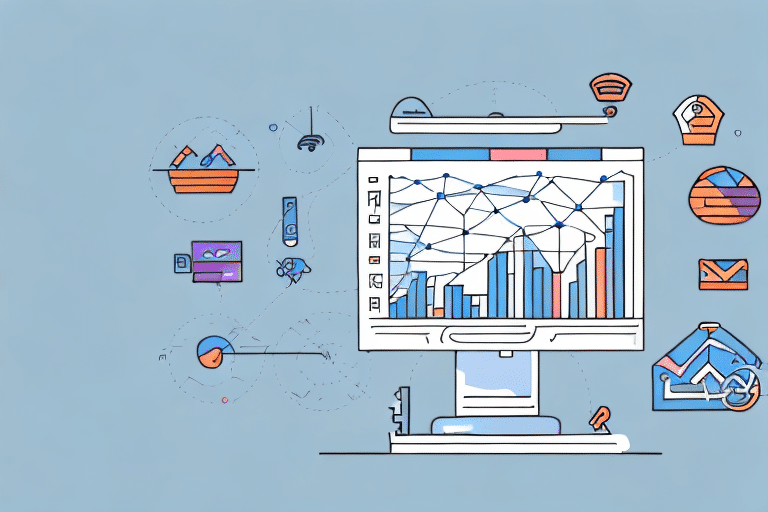The Importance of KPIs for Ecommerce Success
In the competitive realm of ecommerce, Key Performance Indicators (KPIs) are essential for measuring and driving a business's success. KPIs provide businesses with tangible metrics that reflect their performance against specific goals, enabling informed decision-making and strategic planning.
By monitoring KPIs, ecommerce businesses can gain insights into customer behavior, sales trends, and operational efficiency. This data-driven approach allows companies to identify strengths, address weaknesses, and capitalize on opportunities in the market. Additionally, KPIs foster a culture of accountability and continuous improvement, motivating teams to achieve and exceed their targets.
According to a [Shopify report](https://www.shopify.com/blog/ecommerce-metrics), businesses that actively track and analyze their KPIs are 1.5 times more likely to experience revenue growth compared to those that do not. This underscores the critical role that KPIs play in the sustained success of ecommerce ventures.
Top Performance Indicators to Track in Ecommerce
Focusing on the right KPIs is crucial for understanding and enhancing your ecommerce performance. Here are the top KPIs that every ecommerce business should monitor:
- Conversion Rate
- Average Order Value (AOV)
- Customer Lifetime Value (CLV)
- Cart Abandonment Rate
- Website Traffic
- Customer Acquisition Cost (CAC)
- Revenue per Visitor (RPV)
- Email List Growth Rate
- Social Media Engagement
- Product Performance
Conversion Rate
The percentage of website visitors who complete a desired action, such as making a purchase. A higher conversion rate indicates effective marketing and user experience.
Average Order Value (AOV)
The average amount spent by customers per transaction. Increasing AOV can significantly boost overall revenue without acquiring new customers.
Customer Lifetime Value (CLV)
The total revenue a business expects from a single customer account throughout their relationship. High CLV indicates strong customer loyalty and satisfaction.
Cart Abandonment Rate
The percentage of shoppers who add items to their cart but do not complete the purchase. Reducing cart abandonment can directly increase sales.
Setting and Achieving Realistic KPI Goals
Establishing realistic KPI goals is fundamental to measuring and enhancing ecommerce performance. Goals should be Specific, Measurable, Achievable, Relevant, and Time-bound (SMART criteria).
Consider the following steps when setting KPI goals:
- Align with Business Objectives: Ensure KPIs support the overall goals of the business, such as increasing market share or enhancing customer satisfaction.
- Analyze Historical Data: Use past performance data to set achievable targets and identify areas for improvement.
- Monitor Market Trends: Stay informed about industry developments to set relevant and timely goals.
- Regular Review and Adjustment: Continuously assess KPI performance and adjust goals as necessary to respond to changing business environments.
For example, if your current Conversion Rate is 2%, a realistic goal might be to increase it to 2.5% over the next six months through website optimization and targeted marketing campaigns.
Measuring Ecommerce Performance with KPIs
Effectively measuring ecommerce performance involves consistent tracking and analysis of KPIs over specified periods. This process provides insights into how well the business is performing relative to its goals and highlights areas that require attention.
Key practices include:
- Regular Reporting: Establish a routine for generating KPI reports (e.g., weekly, monthly) to monitor ongoing performance.
- Benchmarking: Compare KPI performance against industry standards or historical data to gauge success.
- Data Visualization: Utilize charts and graphs to make data more understandable and actionable.
- Actionable Insights: Translate KPI data into strategic actions that drive business improvements.
For instance, monitoring the Customer Acquisition Cost (CAC) alongside Customer Lifetime Value (CLV) can help determine the sustainability of marketing investments. A CLV that significantly exceeds CAC indicates a healthy return on investment.
Tools and Analytics for Tracking Ecommerce KPIs
Leveraging the right tools and analytics is essential for accurate KPI tracking and analysis. Here are some of the best tools available:
- Google Analytics: Offers comprehensive tracking of website traffic, user behavior, and conversion metrics.
- Adobe Analytics: Provides advanced segmentation and real-time data analysis for in-depth performance insights.
- Kissmetrics: Focuses on customer behavior tracking and cohort analysis to understand user engagement.
- Mixpanel: Specializes in tracking user interactions and performing funnel analysis to optimize conversion paths.
These tools enable businesses to collect, analyze, and visualize KPI data effectively, facilitating informed decision-making and strategic planning.
According to a [Salesforce survey](https://www.salesforce.com/resources/research-reports/state-of-marketing/), 67% of high-performing companies use advanced analytics tools to drive their marketing strategies, highlighting the importance of robust analytics in ecommerce success.
Common Mistakes and Best Practices in KPI Tracking
While tracking KPIs is vital, businesses often encounter pitfalls that can undermine their efforts. Common mistakes include:
- Focusing on Irrelevant KPIs: Tracking metrics that do not align with business goals can lead to misguided strategies.
- Ignoring Data Quality: Inaccurate or incomplete data can result in faulty analysis and poor decision-making.
- Overcomplicating Metrics: Using too many KPIs can create confusion and dilute focus from key objectives.
- Failing to Act on Insights: Collecting data without implementing changes based on insights offers little strategic value.
To avoid these mistakes, adhere to the following best practices:
- Select Relevant KPIs: Choose metrics that directly impact your business objectives.
- Ensure Data Accuracy: Use reliable tools and validate data sources to maintain data integrity.
- Limit the Number of KPIs: Focus on key metrics that provide the most significant insights.
- Implement Actionable Strategies: Use KPI insights to inform and drive strategic business decisions.
The Future of Ecommerce KPIs: Trends and Predictions
As technology evolves, so do the methods and tools for tracking ecommerce KPIs. Future trends in KPI tracking include:
- Artificial Intelligence and Machine Learning: Enhanced predictive analytics and automated insights will provide deeper understanding of customer behavior and market trends.
- Real-Time Data Tracking: Immediate access to KPI data will enable more agile and responsive business strategies.
- Integration of Omnichannel Data: Consolidating data from multiple channels (e.g., online, mobile, in-store) will offer a comprehensive view of performance.
- Personalization Metrics: Tracking personalized customer interactions and experiences will become increasingly important for customer retention and satisfaction.
Staying abreast of these trends will empower ecommerce businesses to adapt their KPI strategies, ensuring continued relevance and competitiveness in a rapidly changing marketplace.
In conclusion, KPIs are indispensable for driving ecommerce success. By meticulously selecting, tracking, and analyzing the right KPIs, businesses can make informed decisions, optimize performance, and achieve sustained growth in the dynamic world of online commerce.






















